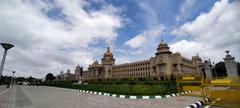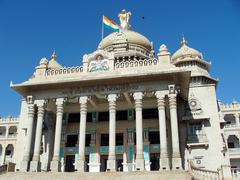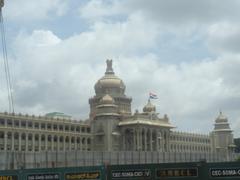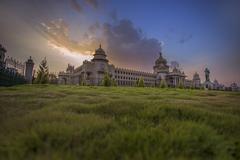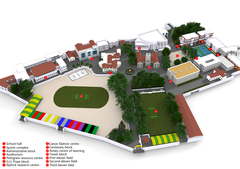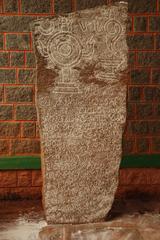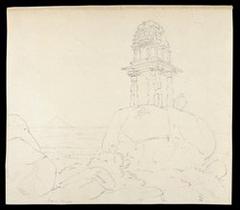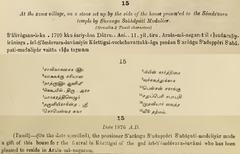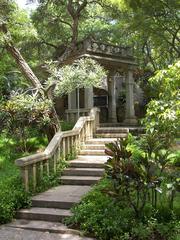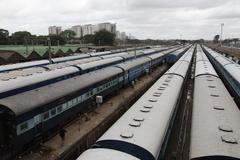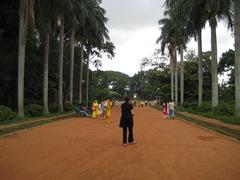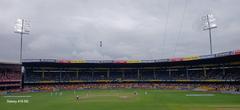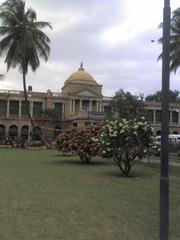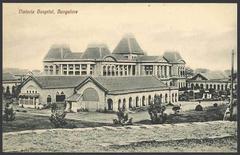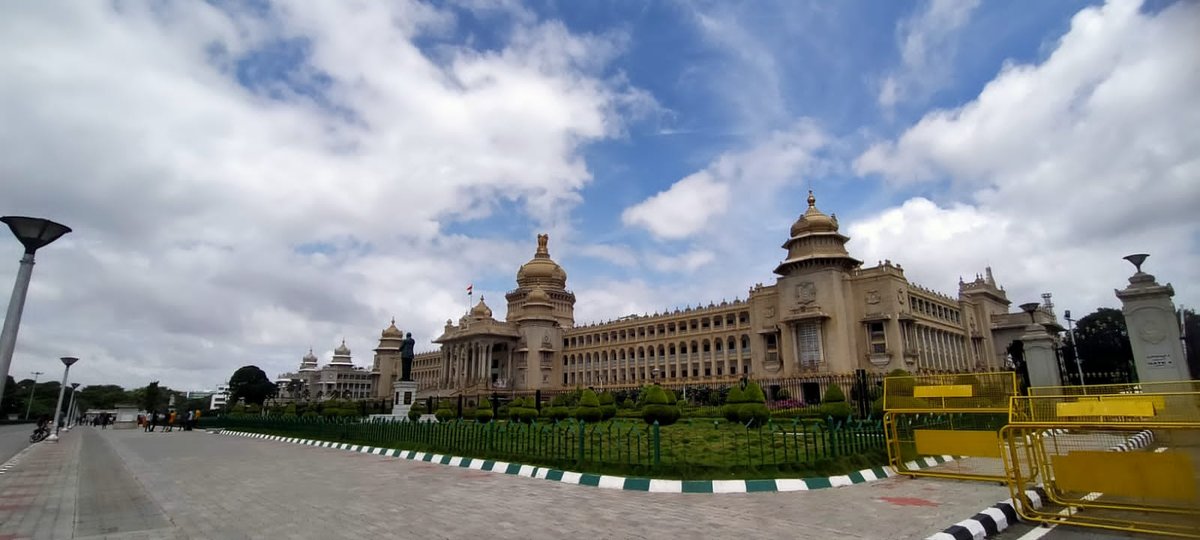
Vidhana Soudha Bengaluru: Visiting Hours, Tickets, and Historical Significance
Date: 14/06/2025
Introduction
Vidhana Soudha, located in the heart of Bengaluru, is not only the seat of Karnataka’s legislative assembly but also an architectural masterpiece and a symbol of the state’s democratic ethos and cultural heritage. Conceived under the visionary leadership of Chief Minister Kengal Hanumanthaiah and inaugurated by Prime Minister Jawaharlal Nehru in 1956, Vidhana Soudha was designed to reflect the dignity, sovereignty, and aspirations of Karnataka. Its distinctive Neo-Dravidian style—blending traditional South Indian temple motifs with modern engineering—makes it a unique landmark and one of India’s largest legislative buildings. The building’s iconic granite façade, intricate carvings, and central dome crowned with the Lion Capital of Ashoka reflect both artistic grandeur and the enduring strength of Karnataka’s democratic institutions. Vidhana Soudha also serves as a vibrant civic and cultural hub, hosting events that celebrate the state’s literary and artistic traditions. This comprehensive guide offers detailed information on history, architecture, visiting hours, ticketing, accessibility, travel tips, and nearby attractions, helping you make the most of your visit to this iconic Bengaluru site (eindiatourism.in, wildvalley.in, dwello.in).
Contents
- Origins and Historical Context
- Construction Timeline and Key Figures
- Architectural Vision and Symbolism
- Materials and Engineering Techniques
- Civic and Political Importance
- Visitor Information
- Visiting Hours
- Tickets and Entry
- Accessibility
- Travel Tips
- Special Events
- Nearby Attractions
- Recent Developments and Public Engagement
- Frequently Asked Questions (FAQ)
- Visuals and Media
- Additional Resources and Links
- Summary and Call to Action
Origins and Historical Context
Vidhana Soudha was conceived during the post-independence era as a monumental symbol of Karnataka’s legislative power and cultural identity. The need for a new legislative building arose as the old Attara Kacheri, a colonial structure, became inadequate for the state’s expanding administrative needs. Kengal Hanumanthaiah, then Chief Minister, envisioned an edifice that would capture the state’s pride and aspirations. The building’s foundation stone was laid by Jawaharlal Nehru on July 13, 1951, and construction began soon after, with a clear intent to break from colonial architectural influences and showcase indigenous artistry (eindiatourism.in).
Construction Timeline and Key Figures
The construction of Vidhana Soudha spanned from 1951 to 1956, employing over 5,000 local artisans and laborers at its peak. Chief Minister Kengal Hanumanthaiah played a pivotal role in driving the project, ensuring the use of local materials and craftsmanship. The chief architect, B.R. Manickam, designed the building to reflect both historical legacy and modern ambitions. The project cost ₹1.75 crore—an immense sum for the period—reflecting its scale and significance (eindiatourism.in).
Architectural Vision and Symbolism
Neo-Dravidian Style and Inspirations
Vidhana Soudha exemplifies Neo-Dravidian architecture, drawing inspiration from South Indian temples such as Brihadeshwara in Tanjore and Somnathpur in Karnataka. Its carved pillars, arches, and cornices evoke the grandeur of the Chalukya, Hoysala, and Vijayanagar dynasties (wildvalley.in). The structure features four prominent domes at each corner and a striking 60-foot central dome crowned by the Indian national emblem—the Lion Capital of Ashoka.
Symbolic Features
Every element of Vidhana Soudha’s design carries meaning. The 45-step grand entrance, guarded by a four-headed lion sculpture, symbolizes courage, power, pride, and confidence. The inscription “Government Work is God’s Work” at the entrance encapsulates the building’s role as a “temple of democracy” (wildvalley.in). The use of locally sourced granite and decorative stones like ‘Magadi pink’ and ‘Turuvekere black’ not only brings strength but also showcases the region’s geological wealth.
Engineering and Materials
Constructed almost entirely from granite, Vidhana Soudha’s massive columns and intricate carvings are a testament to skilled craftsmanship. Traditional chiseling and hand-polishing techniques were combined with modern engineering, resulting in a structure that embodies both tradition and innovation (wildvalley.in).
Civic and Political Importance
Vidhana Soudha is the seat of Karnataka’s legislative assembly and council, housing offices for the Chief Minister and state ministers. Its grandeur, scale, and strategic central location underscore its role as the epicenter of Karnataka’s governance. The building is also a focal point for public gatherings, cultural events, and national celebrations, often illuminated at night to dramatic effect (dwello.in).
Visitor Information
Visiting Hours
- Exterior Grounds: Open daily; best viewed between 10:00 AM and 5:00 PM.
- Guided Tours (2025): Available Sundays and the second and fourth Saturdays, 10:00 AM to 4:00 PM, subject to legislative schedule and security advisories (newindianexpress.com).
- Night Illumination: The building is beautifully lit on Sundays and public holidays, making evening visits particularly memorable.
Tickets and Entry
- Exterior Viewing: Free, no ticket required.
- Guided Tours: ₹50 per adult; students up to Class 10 or under 16 years can join free with a valid ID. Tickets are available through the Karnataka State Tourism Development Corporation (kstdc.co), and original physical ID is required for entry.
Accessibility
- The premises are wheelchair accessible with ramps and designated parking.
- Assistance for differently-abled visitors is available upon advance request.
- Some interior areas may have limited accessibility due to heritage constraints.
Travel Tips
- Carry a valid, original photo ID for security checks.
- Wear comfortable footwear as the grounds are extensive.
- Photography is allowed outside; restrictions apply inside.
- Use public transport where possible due to limited parking.
Special Events
Vidhana Soudha hosts major public events, including the Karnataka Book and Cultural Festival, which features literature, arts, and cultural performances, and attracts large crowds (curlytales.com, outlooktraveller.com, hindustantimes.com). The building is also illuminated for national holidays, drawing visitors for night photography.
Recent Developments and Public Engagement
Book and Cultural Festival
In February–March 2025, Vidhana Soudha hosted Karnataka’s first Book and Cultural Festival, transforming the building into a lively venue for literature, arts, and performances. The event included a literature festival, a major book fair (with 80% stalls dedicated to Kannada literature), and free public entry, aiming to foster reading and cultural appreciation among youth (curlytales.com, outlooktraveller.com).
Public Access and Guided Tours
For the first time, guided walking tours of Vidhana Soudha were introduced in June 2025. Tours are available on select weekends, accommodating up to 300 visitors per day, with each tour lasting 90 minutes and available in Kannada and English. The initiative is designed to foster civic awareness and allow the public a rare glimpse inside the “Temple of Democracy” (newindianexpress.com, clubmahindra.com).
Nearby Attractions
While visiting Vidhana Soudha, explore these nearby Bengaluru sites:
- Cubbon Park: A 300-acre green oasis ideal for walks and picnics (YoMetro).
- Attara Kacheri (Karnataka High Court): A heritage red-brick building with Greco-Roman architecture (ExploreBees).
- Venkatappa Art Gallery: Exhibiting works by K. Venkatappa and contemporary artists.
- Visvesvaraya Industrial and Technological Museum: Interactive science and technology displays.
- Jawaharlal Nehru Planetarium: Astronomy shows and exhibits.
- Bangalore Palace: Tudor and Gothic-style palace 3 km away.
- Lalbagh Botanical Garden: Known for its glasshouse and flower shows (Savaari).
- Freedom Park: Former jail turned park commemorating India’s freedom struggle.
For more attractions, see YoMetro’s guide.
Frequently Asked Questions (FAQ)
Q1: What are the visiting hours for Vidhana Soudha?
A1: Exterior grounds are open daily; guided tours are available Sundays and the second and fourth Saturdays, 10:00 AM–4:00 PM.
Q2: Are tickets required to visit Vidhana Soudha?
A2: No tickets are needed for the exterior. Guided tours cost ₹50 per adult; students up to Class 10/under 16 years are free with valid ID.
Q3: Is Vidhana Soudha accessible for differently-abled visitors?
A3: Yes, with ramps and assistance available upon request, though some interior areas may have limited access.
Q4: Can I take photographs inside Vidhana Soudha?
A4: Photography is allowed outside; restricted inside, especially in sensitive zones.
Q5: How can I book a guided tour?
A5: Book through the Karnataka State Tourism Development Corporation or onsite, subject to availability (kstdc.co).
Q6: What are some nearby attractions?
A6: Cubbon Park, Karnataka High Court, Venkatappa Art Gallery, Bangalore Palace, Lalbagh Botanical Garden.
Visuals and Media
- High-resolution images of Vidhana Soudha’s façade, central dome, and illuminated night views.
- Interactive map showing Vidhana Soudha’s location relative to other attractions.
- Virtual tour option available via the official Karnataka tourism website.
Additional Resources and Official Links
Summary and Call to Action
Vidhana Soudha stands as a testament to Karnataka’s democratic spirit, architectural excellence, and rich cultural heritage. Recent initiatives—such as public guided tours and cultural festivals—have made it more accessible and engaging for visitors. To fully appreciate this landmark, check updated visiting hours, book a guided tour, and explore nearby attractions for a comprehensive Bengaluru experience. For more travel guides, insights, and real-time visitor updates, download the Audiala app and follow our channels.
